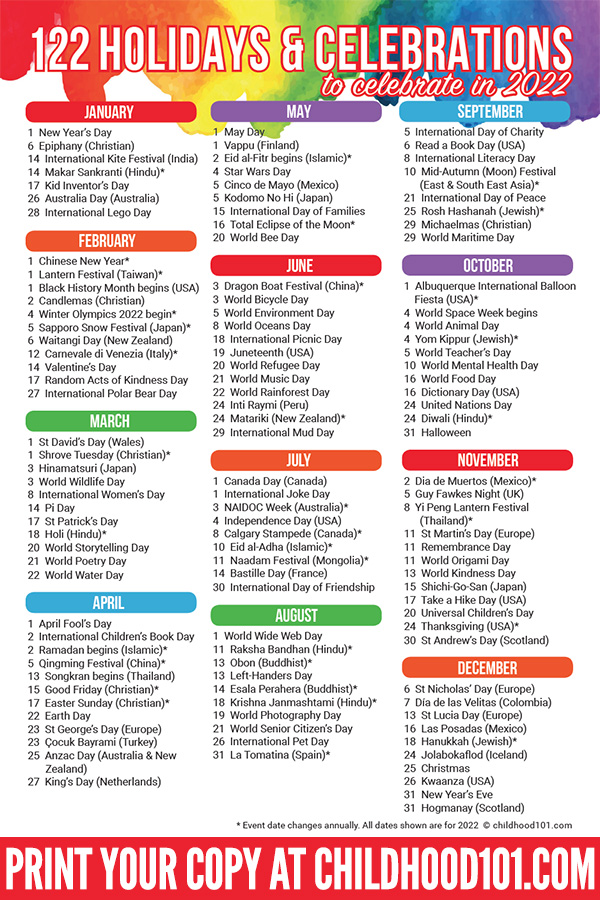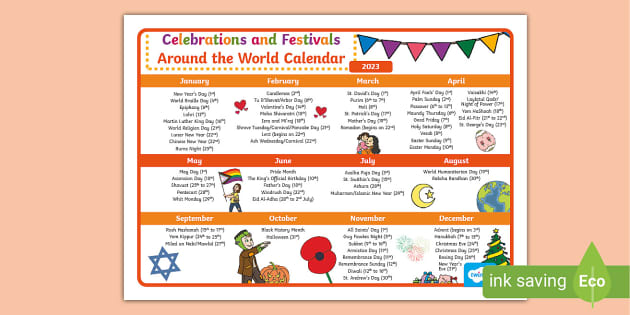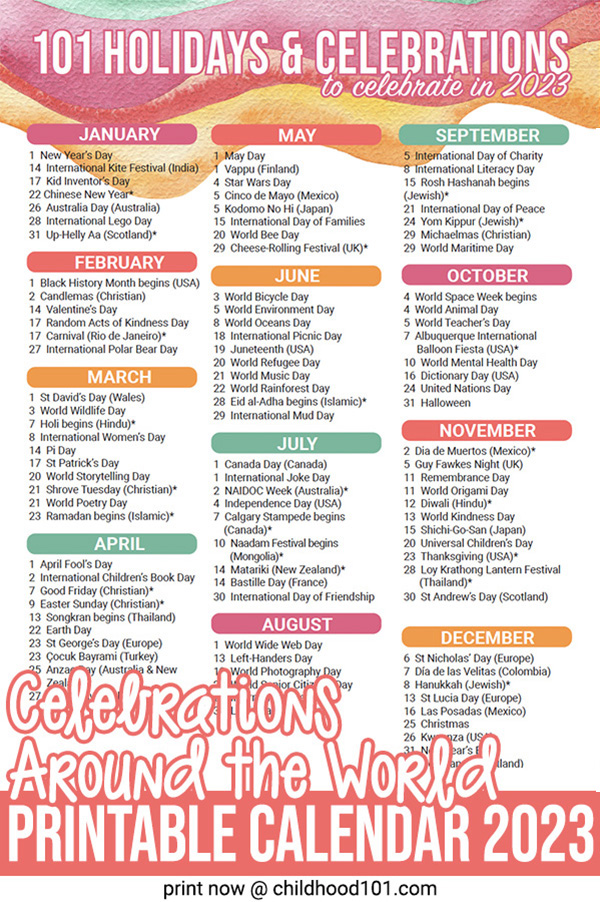A World of Celebrations: A World Calendar of Festivities
Associated Articles: A World of Celebrations: A World Calendar of Festivities
Introduction
With enthusiasm, let’s navigate by the intriguing subject associated to A World of Celebrations: A World Calendar of Festivities. Let’s weave fascinating info and provide contemporary views to the readers.
Desk of Content material
A World of Celebrations: A World Calendar of Festivities

The world is a vibrant tapestry woven with various cultures, every thread shimmering with distinctive traditions and celebrations. A world calendar of festivities reveals a wide ranging panorama of occasions, from historic rituals to fashionable extravaganzas, providing a glimpse into the center and soul of humanity. This text explores a collection of these celebrations, highlighting their significance and offering a window into the wealthy cultural heritage they symbolize.
January: A Time for Renewal and Reflection
The 12 months begins with a variety of celebrations reflecting themes of renewal and hope. In lots of Western cultures, New 12 months’s Day marks a contemporary begin, typically accompanied by fireworks, events, and resolutions for the 12 months forward. Nonetheless, different cultures embrace the brand new 12 months with completely different traditions. The Chinese language New 12 months, sometimes falling in late January or early February, is a vibrant pageant celebrated with elaborate lion dances, firecrackers, and household reunions. It is a time for honoring ancestors and welcoming luck for the approaching 12 months, based mostly on the lunar calendar. In Japan, the Shōgatsu celebrations, additionally based mostly on the lunar calendar, are marked by particular meals, visits to shrines, and the sending of New 12 months’s playing cards. The Orthodox Christmas, celebrated on January seventh, follows the Julian calendar and presents a novel perspective on the Christmas season for Japanese Orthodox Christians.
February: Love, Gentle, and Carnival
February is a month brimming with contrasting celebrations. Valentine’s Day, a worldwide celebration of affection and romance, stands in stark distinction to the somber observances of some cultures. Nonetheless, the month additionally sees the colourful Carnival celebrations in numerous elements of the world. Rio de Janeiro’s Carnival is maybe essentially the most well-known, a spectacle of flamboyant costumes, samba music, and joyous parades. Comparable celebrations happen in different elements of Brazil, in addition to in cities like New Orleans (Mardi Gras) and Venice. These carnivals typically precede the Lenten season, a interval of reflection and penitence for a lot of Christians. In lots of elements of the world, February additionally sees the celebration of varied festivals related to mild and the altering seasons, reflecting the anticipation of spring.
March: Spring Equinox and Holi
March marks the arrival of spring within the Northern Hemisphere, a time of renewal and rebirth celebrated in numerous methods throughout the globe. The Spring Equinox, a celestial occasion marking the equal size of day and night time, holds non secular significance for a lot of cultures. In Iran, Nowruz, the Persian New 12 months, falls across the Spring Equinox, a vibrant pageant of household gatherings, conventional meals, and the symbolic planting of seeds. In India, Holi, the pageant of colors, is a joyous celebration marking the victory of excellent over evil, characterised by the throwing of colored powders and water. This vibrant pageant is a testomony to the nation’s wealthy cultural heritage and the spirit of neighborhood. Elsewhere, St. Patrick’s Day, celebrated on March seventeenth, is a worldwide celebration of Irish tradition and heritage, marked by parades, conventional music, and the sporting of inexperienced.
April: Easter and Passover
April witnesses vital non secular celebrations within the Christian and Jewish faiths. Easter, a Christian vacation commemorating the resurrection of Jesus Christ, is widely known with church providers, egg hunts, and household gatherings. Passover, a Jewish pageant commemorating the liberation of the Israelites from slavery in Egypt, is noticed with particular meals, prayers, and the telling of the Exodus story. These celebrations, whereas rooted in several non secular traditions, share a standard theme of hope, renewal, and liberation. In some cultures, April additionally sees the celebration of varied spring festivals, reflecting the abundance and fantastic thing about the season.
Could: Labour Day and Mom’s Day
Could is a month marked by celebrations honoring each the employee and the mom. Worldwide Labour Day, celebrated on Could 1st, is a worldwide commemoration of staff’ rights and achievements. Mom’s Day, celebrated on numerous dates all over the world, is a day devoted to honoring moms and celebrating motherhood. Past these world celebrations, May sees a plethora of native and regional festivals, typically tied to agricultural cycles and the blossoming of nature. Many international locations maintain springtime festivals and festivals, celebrating the abundance of the season.
June: Summer time Solstice and Delight Month
June brings the Summer time Solstice, the longest day of the 12 months within the Northern Hemisphere, a major occasion in lots of cultures. Celebrations typically contain bonfires, rituals, and gatherings, reflecting the facility and vitality of the solar. June additionally marks Delight Month, a worldwide celebration of LGBTQ+ satisfaction and rights. Delight parades and occasions happen all over the world, advocating for equality and celebrating range.
July: Independence Days and Nationwide Celebrations
July is a month wealthy in nationwide celebrations, with many international locations celebrating their independence days. The USA celebrates its Independence Day on July 4th, a day marked by fireworks, parades, and barbecues. Many different international locations additionally have fun their independence or nationwide days in July, reflecting their distinctive histories and identities.
August: Non secular Festivals and Summer time Celebrations
August sees quite a lot of non secular and cultural festivals all over the world. Many international locations have fun numerous non secular holidays, typically tied to native traditions and beliefs. Summer time festivals and out of doors occasions proceed all through August, offering alternatives for neighborhood gatherings and celebrations.
September: Harvest Festivals and Autumn Equinox
September marks the start of autumn within the Northern Hemisphere, a time related to harvest festivals and the gathering of crops. Many cultures have fun the bounty of the harvest with festivals, feasts, and thanksgiving celebrations. The Autumn Equinox, marking the equal size of day and night time, additionally holds significance for some cultures.
October: Halloween and Diwali
October brings Halloween, a celebration with roots in historic Celtic traditions, now a worldwide phenomenon of costumes, trick-or-treating, and spooky enjoyable. In distinction, Diwali, the Hindu pageant of lights, is a vibrant celebration of excellent over evil, mild over darkness, and information over ignorance. The pageant is marked by the lighting of diyas (oil lamps), fireworks, and household gatherings.
November: Thanksgiving and Remembrance Day
November options Thanksgiving in the USA and Canada, a time for household gatherings and expressing gratitude. Remembrance Day, noticed in lots of Commonwealth international locations, is a day of remembrance for many who died in warfare.
December: Christmas and Hanukkah
December culminates within the main winter holidays of Christmas and Hanukkah. Christmas, a Christian vacation celebrating the beginning of Jesus Christ, is widely known globally with festive decorations, gift-giving, and household gatherings. Hanukkah, a Jewish pageant of lights, commemorates the rededication of the Second Temple in Jerusalem and is widely known with the lighting of the menorah and the consuming of conventional meals. Kwanzaa, a celebration of African-American tradition and heritage, additionally falls in December.
That is only a glimpse into the huge and diversified calendar of celebrations all over the world. Every celebration, regardless of how massive or small, presents a novel perception into the cultural richness and variety of our planet. Exploring these celebrations is a journey of discovery, permitting us to attach with completely different cultures and respect the shared human expertise of pleasure, hope, and neighborhood. By understanding and celebrating these various traditions, we enrich our personal lives and foster a larger appreciation for the world round us.








Closure
Thus, we hope this text has offered beneficial insights into A World of Celebrations: A World Calendar of Festivities. We hope you discover this text informative and helpful. See you in our subsequent article!